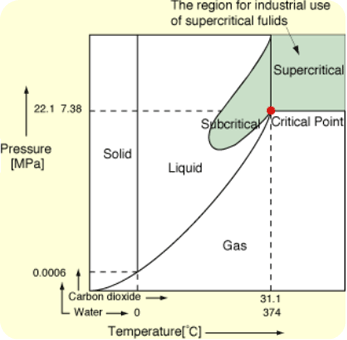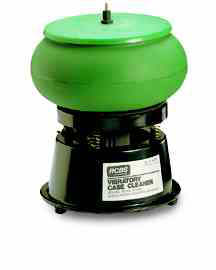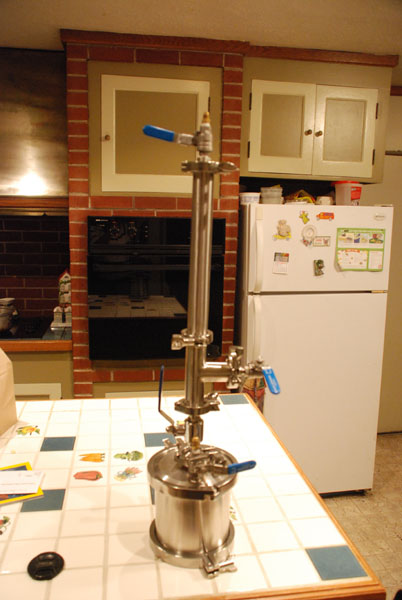Whoop, whoop, lu lu lu lu lu lu lu! Ah just loves new toys!
Ya’ll brothers and sisters looking for support extracting or winterizing with ethanol, will be delighted with Extract Craft’s recent offering of their Source Turbo, vacuum assisted ethanol recovery system.
It is a counter top vacuum assisted refluxing still, about the size of a blender, that uses vacuum to reduce the temperature necessary to boil away the ethanol, so as to preserve more of the monoterpenes, as well as limit changes in their properties.
Hee, hee, hee, they sent us a unit to torture and our preliminary testing supports their enthusiasm.
Eloquentsolution just happened to have several choices of winterized BHO handy, so we selected about 150 ml from a mixed flower extraction for the trial.
 More at:
/extract-craft-source-turbo-ethanol-vacuum-recovery-unit/
More at:
/extract-craft-source-turbo-ethanol-vacuum-recovery-unit/
Sign in to set favorite






Excellent Information. As usual, a well thought out protocol, accurately described with an economy of words. It's up to the individual reader to accept or reject the information presented. I'd like to thank everyone at SFR and all contributors etc., for the time and effort spent educating our community. This site is truly priceless.
Why don't people use teflon coated receptacles when making oil? Sure seems like getting it all out would be a lot easier.
Some don't use Teflon coated vessels, because it can abrade/flake off and get in the end product. If the end product is combusted, it produces HF as a biproduct. GW
Teflon (PTFE) produces fluorine gas, not HF as PFTE has no hydrogen, when heated close to its melting point. So products that are contaminated with flakes can't be vaporized or smoked. Ingested PTFE is harmless, but GW is right don't use it in anything that will be scraped and contains product.
Why would you scrape it? The point is the oil doesn't stick. If you did need to scrape use a teflon or silicone spatula.
Why would a quality coating flake off from a simple pour out? Teflon doesn't react with butane so that's not a problem.
Probably because one is likely to still scrape it out - PFTE is low-stick surface not truly a non-stick surface. Also, if the material hardens or is sufficiently viscous then one can't pour it out even if it doesn't stick.
Like I said as long as you use the proper tool it shouldn't get in the product. Don't use a metal fork. I'm not trying to be a dick it just seems everyone is doing it the hard way. A non stick collection vessel poured onto a non stick sheet pan would be the easiest way. No more parchment. I mean the Oil Slick sheets are teflon and people use those.
If one is using a teflon sheet, you are correct. The problem comes in giving general advice regarding teflon collection vessels, which generally have narrower mouths than bodies, or have screw-on caps (the act of screwing on/off the cap will create flakes).
You can get any container custom coated.
Neither does cooking, but Teflon coatings deteriorate and abrades away anyway. That makes some folks uncomfortable enough that they don't use if for cooking either. GW
The post is by the site owner - their site, their rules.
While the differences probably won't matter for your use, the downside to using vacuum while distilling is that it also reduces the boiling point of everything else, including those terpenes you want to keep. Fraction distillation is needed to minimize the lose of the terpenes, which this unit can't do. I will admit that it is a cute unit and cleaver.
"It is a counter top vacuum assisted refluxing still, about the size of a blender, that uses vacuum to reduce the temperature necessary to boil away the ethanol, so as to preserve more of the monoterpenes, as well as limit changes in their properties." Not the great panacea, or answer to the maidens prayers, but the key words here are "more" and "property change." Comparing the results to a pot still, using temperatures in the decarboxylation range and operating under positive pressure, the vacuum still produces a different, less ravaged end product. Mostly what I like about this unit, is that it is clever in the way it goes about achieving its goal, and is easy for the average non scientific person person to operate, as compared to a more expensive rotovape. It is also supportive of QWET extraction, and BHO/CO2 winterization, so offers notable utility. GW
I apologize in advance for asking this question in a reply but I've read that when using a dewaxing column with dry ice cannabinoids can actually freeze with the lipids because the temperature is lower than -50f. Is winterizing a better method for obtaining a higher yield than dry ice dewaxing?
ANY attempt to freeze the waxes out of a crude extract will result in some lose of the cannabinoids because the cannabinoids are wax soluble. Now it may not be sufficiently significant for you to care, but it does happen. Chromatography can remove the waxes and clean-up the crude extract in one step while avoiding distillation.
Choice of process, depends heavily on the end product desired. Most have their strong and weak points. Precipitating waxes at ultra low temperatures can indeed also precipitate and include some cannabinoids. You can wash the waxes and recover most of them. Winterizing with ethanol costs more of the monoterpenes. Because of its higher boiling point, it is harder to purge than LPG. I prefer to extract at -30/40C, so as to not extract many plant waxes in the first place. There are typically not enough waxes present to justify winterizing, unless you are planning to subsequently short path distill it. GW
I'm truly honoured to receive your reply GW. I have a two stage dewaxing setup and my desired product is a stable shatter. Maybe if I don't fill the dry ice column entirely it will be closer to -30 or -40. I'm still wet behind the ears when it comes to extracting so any and all input is sincerely appreciated. Thank you Dbonemalone
My apologies I misunderstood I thought you meant you dewax at -30 to -40C. I have a CLS, can you please educate me in how I can extract at those temperatures. Thank you
A couple of different ways in use for the purpose, both requiring that you start with the column and material pre-frozen to subzero temperatures. One is to inject the LPG through a 3/8 or 1/2" stainless coil sitting in a dry ice and alcohol bath. The one we used at WolfWurx, was to inject through a counter flow heat exchanger, using liquid N2 on the other side for coolant.
When I dewax I do so at -10C in centrifuge tubes and spin them at 4000 rpm. It really packs the waxes down and anything else that precipitates. Winterizing the extract then immediately centrifuging produces light red oils that taste like cherry after I cook it down. However, except for special occasions or research I no longer dewax. I remove the low boiling terps. The wax left in makes the product easy to work with. It gives the vape a delightful velvet sensation when there are substantially no solvents (terps) present in them. Plus, no matter how careful I am, each process used holds up medicine. A little is lost at each stage. I have found it to be an unacceptable loss of product given that simple removal of the low end boil terps (like alpha pinene) produces a pleasant vaping experience. My data shows that at least 12% of the weight of standard dispensary extract is pinene, and traces of unidentified clear liquids as well (likely water based). This figure seems to be pretty consistent across strains. The MSDS on pinene says do not breath it or get it in the eyes, on skin, etc, which by the way is the same for the MSDS for beach sand. Pinene is highly flamable but beyond that is a tremendous respiratory irritant (like sand). Remove the pinene and keep the vape set below limonene (360F vape setting) and I can avoid all respiratory irritation that interferes with a good deep vape hit. I bump it up for a bit higher at times because I have learned that the high fraction end irritants like limonene have a slow onset of irritation and seem to speed and strengthen the effects unlike the pinene which makes me gag. Likely because I can inhale deeply plus the limonene as a solvent helps penetrate the mucous layer in the lungs.
I'm confused. I thought it was against the rules to promote a product on this site. Obviously that doesn't apply to special people.
"Skunk Pharm Research blog site, is intended as a public information forum, devoid of brand bias, beyond what we develop ourselves through empirical testing." There are no special people and there is no product bias here. We empirically tested it, reported the results, and will test their competitor with the same zeal. The big difference is that Extract Craft didn't just post their own marketing information on site, versus us testing it and posting the results ourselves. Does that help your confusion? GW PS: Stay tuned for more product tests and published results.